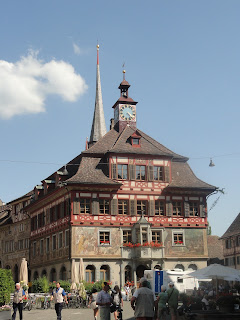Although my ethnic heritage basically includes every
Germanic language speaking country in Europe outside of Scandinavia, the
Wormans themselves originally immigrated to the US from a village outside of
Zurich, Wiesendangen, where members of the Wuhrmann (the non-Anglicized version
of my last name) family still live today.
I had visited Paul and Bethli Wuhrmann, a lovely older couple who live there
on a family vacation ten years earlier and headed back to Wiesendangen to visit
them again. It was great to reconnect with them, especially now that I can
speak German. Paul doesn’t speak any English and Bethli’s English is limited,
so speaking in German increased our ability to communicate substantially.
However, Swiss German and Standard German are completely different dialects so
communicating was still challenging. In particular, trying to understand Swiss
German conversations was difficult. Although with a lot of concentration and
careful listening, I could catch a lot of the words and could usually
understand the broad idea, I felt fairly incapable of contributing
substantially to the conversation. Thankfully, people were usually willing to
explain things further in Standard German or in English so I wasn’t always
confused.
Despite the occasional language difficulties, I had a
wonderful visit and Switzerland remains one of my favorite countries in Europe.
Many of the places we visited I had seen on my previous trip but it was great
to go back now that I’m older and can appreciate the experience more.
On my first day, we visited Säntis, a mountain located near
their home. I hadn’t been in the
mountains yet this semester, so it was great to see some of the gorgeous Alpine
scenery. There’s a cable car up to the summit of Säntis and from the top, the
view are breathtaking.
The next day, we visited Wiesendangen itself, including the
church my ancestors attended before they immigrated.
The rest of the day, we traveled around some of the
neighboring villages. Wiesendangen is planning to merge this fall with the
adjoining municipality due to low population. A bus traveled throughout the day
between the various villages in the two municipalities so people could see the
villages in their future municipality. At each of the stops there was food,
photo displays of the history of the village, and other activities. At one
village, we were able to visit both dairy and cherry farms. I found the culture
of small, family operated farms to be great. I think US food production has
become far too commercialized.
The experience of the day, along with attending the
neighborhood potluck that night and just staying with Paul and Bethli in of
itself meant that I was more immersed in the local culture than I have been
during my other travel which was wonderful. Here are some photos of their
beautiful house and neighborhood.
We visited the municipality history museum as well. Although
pretty small, it gives a good sense of what life was like historically in
Wiesendangen.
The flag on the building is the official symbol of
Wiesendangen.
On my last day, we visited the Rheinfall, a waterfall on the
Rhine River. It’s an impressive waterfall with a viewing platform that gets
surprisingly close to the water. We also took a short boat ride near the falls
as well, which was fun.
Finally, we visited a small village known for the beautiful
murals on its buildings. The town square and intricate wall murals were
charming.



































No comments:
Post a Comment